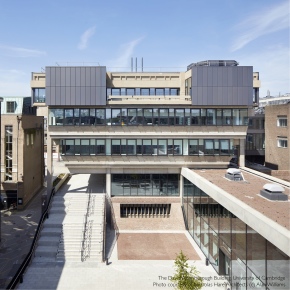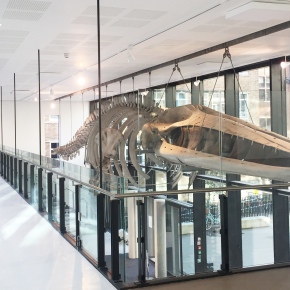
Cambridge University building enters 21st century with advanced glazing from Pilkington
With advances in glazing technology, modern buildings tend to be bright, spacious interiors that are quiet, comfortable in temperature and efficient to heat, differentiating them from their historic counterparts.
The opening of the David Attenborough building in Cambridge is a recent example of this. Owned by the University of Cambridge and housing the Cambridge Conservation Initiative and the Museum and Department of Zoology, the building was originally completed in 1971 in the brutalist style popular at the time.
As one of the poorest energy performers in the university’s estate thanks to single-glazing and a lack of insulation, when refurbishing, the main goals of the architects were to improve accessibility, openness and energy performance of the space. As a result, glazing played a key role in achieving these aims.
A new atrium has been created in the centre of the building, descending through four floors, with the aim of helping light flood deep into the main body of the existing building. Double-glazed units comprising two panes of heat-strengthened Pilkington Optilam clear laminated glass were used on the roof.
The atrium contains a stairwell surrounding a fully glazed lift shaft, therefore allowing light to pass down through the space. The new three-storey-high interior living wall featured on the building is then illuminated.
Due to the location of the glass in a key entry and exit route, it needed to meet strict regulations for fire protection. Pilkington Pyrostop was used to address this, a product which has been tested to maintain integrity for 60 minutes and provide 30 minutes’ insulation rating in the event of a fire.
Therefore, occupants are protected from spread of flame, smoke and gas and the heat protection allows time to safely evacuate the building.
A double-height glazed extension at the front of the building has changed the way that visitors enter the museum, with a new entrance. In addition, the new extension space links to a new cafe and also houses some exhibitions from the Zoology Museum.
The amount of solar energy entering the building is reduced while maintaining a high level of clarity for visible light due to the Pilkington Suncool 66/33 coating, featured on the outer pane of the roof light.
The glass surrounding both the existing building and the extension also featured the same coating. These units featured an outer pane of 6mm glass and an inner pane of 10mm Pilkington Optifloat Clear glass, sandwiching a 20mm cavity.
The acoustic performance of the glass is improved by the relatively large cavity, as well as providing excellent thermal insulation.
Pilkington UK Ltds commercial sales manager, Michael Metcalfe said the architects had turned a rather intimidating building in to an inviting place whilst bringing the facility up to date in terms of its energy performance.
Contact:
Pilkington United Kingdom Limited,
Greengate Works,
Sherdley Road,
St. Helens,
Merseyside,
United Kingdom,
WA9 5 DZ
Phone: 01744 692000
Fax: 01744 692569
Visit Pilkington Building Products' website
Visit Supplier's page
Latest news

19th April 2024
ASSA ABLOY: Access solutions can impact sustainability performance across the full life-cycle of a building
Embedding sustainability within any organisation requires a broad, strategic perspective. Scrutiny should include the physical infrastructure itself: According to the IEA, buildings consume around 30% of global energy*. ASSA ABLOY has more…
Posted in Access Control & Door Entry Systems, Architectural Ironmongery, Articles, Building Industry News, Building Products & Structures, Building Regulations & Accreditations, Building Services, Case Studies, Doors, Facility Management & Building Services, Information Technology, Research & Materials Testing, Retrofit & Renovation, Security and Fire Protection, Sustainability & Energy Efficiency, Video of the Week
19th April 2024
British weather doesn't dampen spirit for new HMG Garden Paint
Despite one of the wettest starts to the year on record, customers are starting to plan for brighter days with HydroPro Garden Paint from HMG Paints.
Posted in Articles, Building Industry News, Building Products & Structures, Garden, Innovations & New Products, Paints, Paints, Coatings & Finishes, Restoration & Refurbishment, Retrofit & Renovation, Site Preparation, Sustainability & Energy Efficiency, Waste Management & Recycling
18th April 2024
Abloy UK showcases new digital portfolio at The Security Event 2024
Abloy UK is set to unveil its latest line-up of access control systems at The Security Event 2024, welcoming guests to explore its cutting-edge electromechanical and digital solutions on stand 5/F50.
Posted in Access Control & Door Entry Systems, Architectural Ironmongery, Articles, Building Industry Events, Building Industry News, Building Products & Structures, Building Services, Doors, Exhibitions and Conferences, Facility Management & Building Services, Health & Safety, Information Technology, Retrofit & Renovation, Security and Fire Protection
18th April 2024
Strand is a Failsafe Choice for Emergency Exit and Panic Hardware
In times of emergency, you’re in safe hands with Strand Hardware. Although there are many considerations for building specification, few decisions can be as critical as selecting the right emergency exit/panic hardware.
Posted in Access Control & Door Entry Systems, Architectural Ironmongery, Articles, Building Industry News, Building Products & Structures, Building Services, Doors, Facility Management & Building Services, Health & Safety, Restoration & Refurbishment, Retrofit & Renovation, Security and Fire Protection
 Sign up:
Sign up: 